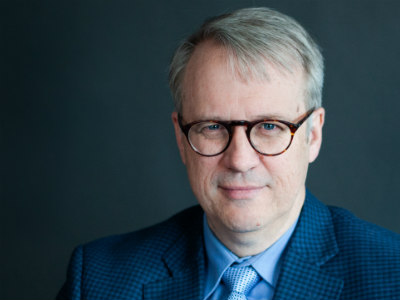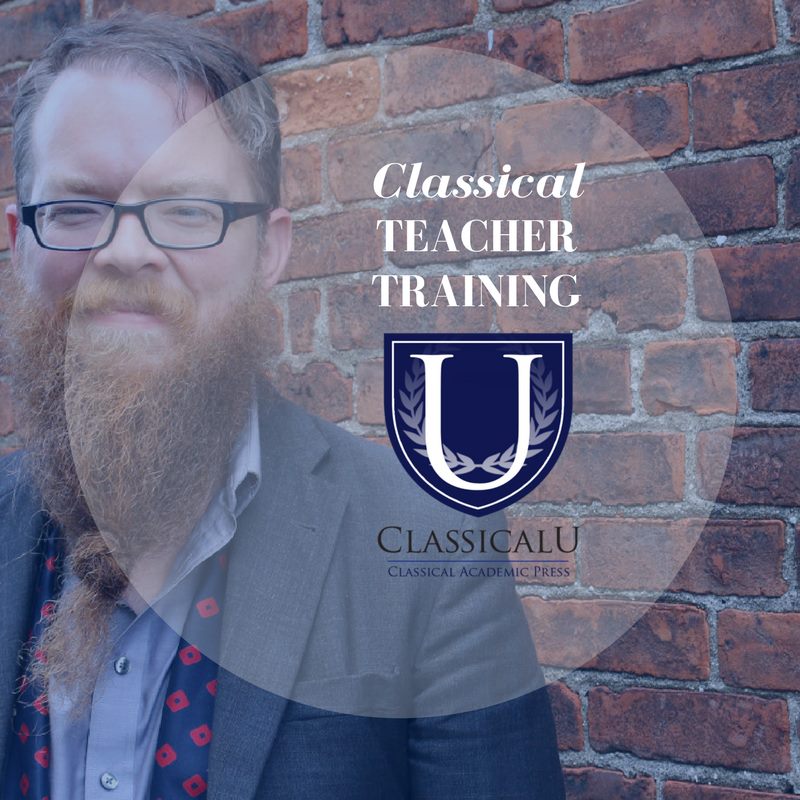In a previous article, I argued that classical schools, like their progressive counterparts, “pile it on” or have too many periods and teach too many subjects. In this article, I argue that classical schools also “cut up” the classical curriculum into too many sections, resulting in more diffusion and fragmentation than we should countenance. Why do we have so many “subjects”? We have lost our ideal for what unifies and harmonizes education and human life.
In 2012, British author and speaker Sir Ken Robinson delivered a speech at the Richmond Forum on revolutionizing education in America. After hearing his presentation, a student in the audience asked him a question along these lines: “Do you think it wise for us to integrate our studies across the disciplines?” Sir Robinson’s response was that the world is already integrated—it is we who have disintegrated it.
I love the way he turned common thinking about education on its head with such a comment. The world with all of its fascinating variety, from bubbles (why are they always spherical?) to elephants, is already an integrated whole.
In our mad drive to break things down and apart, we have lost sight of the wholeness of things. “Analysis” (from the Greek analuein, “to loosen, dissolve”) is the word we use for breaking things down into their constituent parts. Analysis is good—we do need to study the various parts of an engine, a molecule, or the human body. But a study of the parts alone is never sufficient without remembering that the parts, well, are part of something. A piston ring is interesting; a metal block that contains a string of countless explosions (the internal combustion engine) is astonishing.
The world used to be called a cosmos—one great, big, beautiful ornament, or an arranged harmony. It was often compared to an organism—something living, something vital. The cosmos was an enchanted whole, existing for a purpose, and containing various integrated elements, all moving toward ends according to their essence and design. Put another way, everything that existed had a cause: a cause for its form and a cause for its purpose or end. Nothing was a mere, brute fact; all things were coordinated and “going somewhere.”
We have sanitized the living cosmos, even sterilized it. And it seems the most we can do with a purposeless world is to cut it up into pieces for careful examination. This began to happen in earnest during the Enlightenment and the Scientific Revolution. Studying the material of things (and, for many, becoming convinced there was nothing beyond the material), we sought to put nature on the rack, as Francis Bacon said, and extract her secrets.
Let me give credit: We did learn a thing or two, for the deep study of material reality does indeed merit study and reward it. With the telescope and microscope, we saw things we had never seen before. We were astonished to discover so many more parts to our world that our unaided human eyes could never see. And the great scientists (Kepler, Galileo, Bohr, etc.) expected that these new parts were in fact ordered, that they in fact did have purposes and ends, even if they were kept secret for centuries. In fact, most of these seminal scientists assumed an invisible order behind the material order they observed—they studied matter deeply without becoming materialists.
So I do not reject the deep study of material reality; I only reject the premise that material reality is a dead reality. I do not reject examining the various parts of any whole, but analysis need not become an autopsy. The world derives its life from its divine origin; once that is rejected, analysis will become a lopsided “parsing” of the world with no vivifying unity. With no unity in the cosmos, we will have no unity in education—no more genuine universities, where the many verses are folded into one (the Latin ūnus, “one,” and versus, “toward, facing”). Instead we get fragmented departments and various subjects.
Our common current vocabulary does signal our breakup. Our world is fragmented, and therefore so are our schools, studies, and terms. As a fragmented school is not unified, it is therefore weak, therefore fragile. In Latin, frangere means “to break,” frāgmentum means “something broken,” and fragilis means “brittle, fragile, fleeting.” The Latin simply reminds us of the connection between breaking up and breaking down.
Our word “college” used to signal a “collection” of scholars who gathered to read (see the lectio in our word “collection”) and teach a common curriculum; now it does not. We are left with traditional educational words (university, college, liberal arts, grammar, logic, rhetoric) that have become squishy and vague, connoting something revered and cloudy from a past we have only recently forgotten. Contemporary colleges, working out the latest expression of our reigning American ideas of materialistic relativism, pragmatism, skepticism, and pluralism, are split and fragmented, likely beyond the possibility of unification. Departments and majors have multiplied, fields of studies have proliferated, and one can get a graduate degree in “areas of study” that even twenty years ago would have been considered bizarre and beyond serious academic inquiry.
When there is no unity, there is also no criteria for what is “academic” or “nonacademic,” for what is excellent or lacking excellence. Without unity, the implications for learning follow logical lines: Why should Shakespeare be considered greater writing than The Vampire Diaries? Why shouldn’t we study “Tree Climbing,” “Getting Dressed in the Morning,” “Lady Gaga and the Sociology of Fame,” or “How to Watch Television”? Colleges can and do offer such courses now, and usually without any sense of irony.
Here is the rub: American high schools have been designed to prepare students for what our colleges and universities have become. The trends on our college campuses become the curricula of our high schools. Classical schools want to return to the studies of a common canon of the Great Ideas and the books that contain them; modern high schools want to (and need to) make students ready for modern colleges without a canon.
Classical schools are working hard to remember what we have forgotten (and to remember that we have forgotten), and have been trying to do so for about thirty years now. It turns out that remembering is hard. It turns out that what was forgotten over two or three generations is not recovered in a single decade. We have been doing good work recovering the classical trivium (first) and then the classical quadrivium (second), while slowly learning to integrate learning and study across the curriculum and cultivate a vibrant culture (third). The work has begun and is well underway. We have not yet, however, come to terms with the way that time and space are ordered in our schools.
Our schools are generally drab, pedestrian, and pragmatic in design. That is to say they look and function like virtually any other modern school. This is not surprising, nor is it really a criticism. We have been formed in these kinds of schools, and our blindness is only healed gradually. Now, however, there are many who are seeing our school buildings and schedules for what they really are: modern and progressive. (Aside: What should a school look like? Visit a monastery or any college at Oxford. Build a school around a garden.)
The ordering of time and space matters, and it matters deeply. We are embodied creatures and our five senses are very good qualities indeed. I will leave behind concerns about our school space and architecture (though these are related dynamically to our use of time and space) to focus on the fragmentation of time. We might say that our buildings are “cut up” in ugly ways; so is time. We cut up time into seven or eight fifty-minute periods with a brief twenty-minute lunch period crammed in the middle (your school may have a thirty-minute lunch period, but measure the amount of time that students actually get to spend eating). Most classical schools follow this pattern as an inherited educational norm (like the way we grade). Most classical schools are just beginning to question the practice.
Thus, we are left with “periods” and “sections.” Even these words connote the science of dividing, rather than unifying or harmonizing. Secāre in Latin means “to cut,” and we indeed cut our way through education. Our word “period” suggests a small unit of time after which we definitely will have to stop. In our class sections and periods, we know that we take a small cut at something and then stop in short order—often just when things were warming up. Our learning is periodic. We constantly start and stop, we cut learning short, we sell learning short. It is no surprise that many American students are inclined to cut classes, or cut school altogether. They want to do what we do to them. We cut school; they cut school.
There is an irony here, because classical schools know that learning should be integrated, and seek to integrate subjects and to integrate faith and learning. You might remember that a whole number in math is called an integer. Both “integer” and “integrity” come from the same Latin root word, integer, literally meaning “untouched” and thus something that is unimpaired, undivided, or whole. Learning should be holistic, for if Ken Robinson is right, the world lies before us already integrated.
But even to call our courses of study “subjects” can be problematic. The word “subject” has a legitimate use as a generic word for any directed matter or study. It is similar to words like “theme” (a general conception running through a composition of some kind) and “topic” (often meaning a more specific idea treated in a section of a composition or speech). The reason I think we have grown comfortable with the word “subject” to refer to courses of study is that we have so widened our “curriculum” that it can include just about anything. Thus, we need to use adjectives to further modify “subjects.” We have traditional subjects, literary subjects, mathematical subjects, vocational subjects, technological subjects, classical subjects, linguistic subjects, and so on. We used to study the liberal arts and the four traditional sciences (natural science, moral or human science, philosophical science, and theological science). There was a time when virtually all that we studied was either an art or a science, and with a clear idea of the difference between the two.
The word “subject” originally meant something “thrown beneath,” as something thrown before you for your examination and consideration. Now virtually anything can be thrown at our feet, and virtually anything is in our modern schools and colleges. Virtually anything one encounters can be a subject, possibly even configured into a four-year degree. While we cut up the curriculum, we find that the curriculum has become a pie as big as the moon—so we must press on with our cutting, as there is so very much to divide.
I know the words “section,” “period,” and “subject” are here to stay and can be used without causing cancer. Still, what if we used some older words instead? Consider the following:
- Art: from ars, artis, which means “skill, craft, craftsmanship.” This is the fitting word for any of the seven liberal arts. Each liberal art is a study in verbal or mathematical skills that find application in any human study or enterprise. Art can also be applied to the fine arts that connote something we make or fashion that is an end (finis, “end”) in itself.
- Science: from scientia, “something known, knowledge.” Any collected, organized body of knowledge can be called a science. In this sense, biology and chemistry are sciences, but so can philosophy and theology be regarded as collected, organized bodies of knowledge, and thus sciences. We use our training in the liberal arts to classify, collect, categorize, arrange, and organize a science. The liberal arts enable us to create sciences.
- Discipline: from diciplīna, which means “learning, teaching, instruction, training, habits, discipline.” A discipula is a student (female) or a learner engaged in a discipline.
- Form: from fōrma, “shape, idea, kind, model, pattern.” The British refer to their “grades” as forms.
- Course: from cursus, “a passage, journey, course.” This word connotes that we together are heading in the same direction to an appointed end.
- Session: derived from sedere, “to sit.” A session is a gathering in which we all come together and sit down to learn.
- Seminar: from sēminārium, “a nursery or seed plot.” This is a place of exploration, discovery, and planting and growing seeds. Often the seminar is conducted around a table.
- Symposium: a Greek word that means literally “with a drink.” This generally connotes a larger gathering of mature learners who gather for discussion, usually hearing from several presenters or lecturers.
- Conventiculum: literally a “coming together.” This Latin word can also designate a place as well as an activity, and may be smaller in scope than a convention.
- Convention: a “coming together” that generally will involve a larger number of people.
- Conference: literally a “bringing together,” often with a small number of people who gather to discuss a given topic.
- Colloquium: literally a “gathering to talk or discuss,” usually on a designated topic. Any class that is dedicated to discussing a particular topic could be called a colloquium. (The plural is “colloquia.”)
- Tutorial: a class in which a tutor guides and instructs either an individual or a small group of students.
- Forum: This Latin word means “marketplace.” A forum today is a gathering for the purpose of discussing questions, often with a larger group, and possibly in a public setting.
- Workshop: a seminar or discussion group that emphasizes the exchange of ideas surrounding a particular art and the demonstration of a technique or skill.
- Disputation: from disputātiō, “discussion, debate, dispute.” A traditional word for a debate in which a resolution or claim is disputed by two parties, following a moderated and formal pattern of exchange.
- Declamation: from dēclāmātiō, “practice in public speaking, oratorical exercise.” A traditional word for a set speech prepared on a theme in which persuasive counsel is given for resolving a dilemma and adopting a wise course of action.
- Oration: from ōrātiō, “a speaking, speech, discourse.” A traditional, general term for a prepared speech.
After contemplating all of the above, why do today’s classical schools, like progressive schools, still fragment the curriculum—still cut school? The answer is simply because classical schools have been busy working on other pressing matters, even pressing priorities. We have been working on reimplementing the seven liberal arts and the Great Books. We have been working on cultivating a culture of wonder and delight.
Over the last thirty years, many of us questioned what we found in our progressive educations, but only recently have we begun to question the wide, sectioned curriculum. To be honest, at first many of us did not have the eyes to see it. Yes, we changed or substituted the subjects. We brought in Latin, logic, and rhetoric—but we still called them “subjects” and treated them as such. It turns out they are not so many subjects among a sea of other subjects. It turns out they are arts that cultivate humans to be the fullest versions of themselves. It turns out they are the occasion and setting for mentorship, formation, and friendship. Perhaps they are holy places where we learn to love the True, Good, and Beautiful. They are not mere subjects.
Now, however, it seems time to dedicate our full attention to the matter of putting back together the pieces of our fragmented curriculum. Just how we might do this will be the subject of my next article, on reunifying our classical curriculum. In the meantime, I welcome your ideas, suggestions, and criticisms.










Dr. Perrin, I love what you are saying here! Our school is working hard to find ways to integrate but, as you say here, we have all been trained up within a fragmented learning model. It is SO HARD to go against the grain. It is going to take a long time. Christ is using this classical renewal as the perfect soil in which the roots of patience must grow. And patience must lay her roots in the heart of any human who desires to integrate the various courses of study for the benefit of rising generations. Christ is using this classical renewal to remind us of how utterly dependent upon Him we all must be. He rejoices over us with singing when we come together, cloaked in humility, with the goal of pointing all things toward His Holy Name. Will you be speaking on this any time soon? If so, I would love to be there. 🙂 If not, keep writing. Thank you for your leadership in this renewal; the ripple effect of your work is moving mountains.
Your cosmos language recalls this from “Imagination and Thought in the Middle Ages” by C.S. Lewis (first delivered as a lecture in 1956, the piece was published posthumously in the 1966 collection of essays called Studies in Medieval and Renaissance Literature):
“Go out on any starry night and walk alone for half an hour, resolutely assuming that pre-Copernican astronomy is true. Look up at the sky with that assumption in mind. The real difference between living in that universe and living in ours will, I predict, begin to dawn on you.”
“…You will be looking at a world unimaginably large but quite definitely finite. At no speed possible to man, in no lifetime possible to man, could you ever reach its frontier, but the frontier is there; hard, clear, sudden as a national frontier.”
“…We find (not now by analogy but in strictest fact) that in every sphere there is a rational creature called an Intelligence which is compelled to move, and therefore to keep his sphere moving, by his incessant desire for God.”
“…The motions of the universe are to be conceived not as those of a machine or even an army, but rather as a dance, a festival, a symphony, a ritual, a carnival, or all these in one. They are the unimpeded movement of the most perfect impulse towards the most perfect object.”
Thanks for this Jesse… Now I must go and read that essay!
I think about this a lot as a homeschool mom who teaches (and tutors to traditional students) the wide spectrum of high school content. The thought that it could actually be done with enough resources nags at me in the midst of my already busy life. The re-envisioning the K-12 curriculum that I imagine does not tether itself too tightly to Western content, though, but also dreams of incorporating content that any missionary in any land could teach for the blessing of the world. I imagine an integrated, chronological narrative core surrounded by ongoing “arts” (skill) practice and research/rhetoric/production that rotates among the disciplines. Will keep my ears open for your progress …
Yes! I’m a missionary in Peru dreaming of starting a classical christian school here, but wondering how to design a curriculum that incorporates all of this and is relevant for both my Latin American students as well as my missionary children from the US and my expat children from all corners of the world… I can’t wait to read the next post on this topic!
Has the follow up article been published?
I am so intrigued!
Dr. Perrin,
What do you think of how Charlotte Mason solved this problem? Here is a sample programme of study for high school that she developed for use in her lifetime: https://archive.org/stream/BoxCM23FileCMC160/i1p1-i5p6cmc160#page/n13/mode/1up
Best regards,
A. Middlekauff
Thank you for this series Dr Perrin!
I am eager to read the next article – is it available – or not out yet?